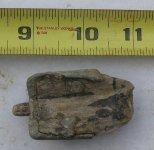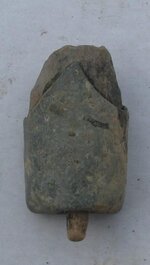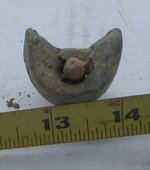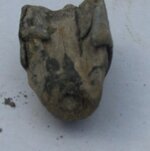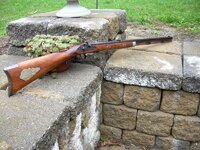I have what I think is a forend cap for an early gun but I want some confirmation from everyone. I think it is lead- is this common? It appears handmade because it isn't perfectly symmetrical. As you can see it appears to have part of the ramrod still present. At first I didn't think the ramrod or infill was wood because it was so hard. Now that it is dried out a little I can dent it with my fingernail, but still seems extra hard for wood. Has anyone heard of this hardening happening for old wood found in water? It was submerged along the edge of a river. The wood was so hard that I couldn't scratch it with a small sharp edged rock that I picked up. The fact that the ramrod is still there (if that is what it is) is intriguing to me and makes me wonder if the rest of the gun is nearby. Does anyone else find that significant? Am I on the right track or is this something else?
Navigation
Install the app
How to install the app on iOS
Follow along with the video below to see how to install our site as a web app on your home screen.
Note: This feature may not be available in some browsers.
More options
You are using an out of date browser. It may not display this or other websites correctly.
You should upgrade or use an alternative browser.
You should upgrade or use an alternative browser.
Likely forend cap
- Thread starter scratcher
- Start date
truckinbutch
Silver Member
I think you are right on track except for the metal id . Silver , german silver , and brass , as well as steel , were used as hardware . Lead could have been used as an emergency repair . I'd be looking for the rest of the rifle .
Upvote
0
- Thread starter
- #3
truckinbutch said:I think you are right on track except for the metal id . Silver , german silver , and brass , as well as steel , were used as hardware . Lead could have been used as an emergency repair . I'd be looking for the rest of the rifle .
Thanks for the reply TButch, I'm glad you agree. I really think it is lead, though. The other thing that made me wonder if it might be something else, is I didn't think it was common for the ramrod to actually go through the cap. Does anyone know if it was commonly done that way on any specific gun type? Thanks
Upvote
0
Bigcypresshunter
Gold Member
- Dec 15, 2004
- 27,000
- 3,339
- Detector(s) used
- 70's Whites TM Amphibian, HH Pulse, Ace 250
- Primary Interest:
- Beach & Shallow Water Hunting
I dont have my Mountain Rifle with me but my ramrod goes through the nosecap and its pewter or a lead based metal. . It looks like this. Ill try to find a better pic. Mine also has 2 screw holes in it. Maybe yours is home made.scratcher said:The other thing that made me wonder if it might be something else, is I didn't think it was common for the ramrod to actually go through the cap. Does anyone know if it was commonly done that way on any specific gun type? Thanks
Attachments
Upvote
0
Bigcypresshunter
Gold Member
- Dec 15, 2004
- 27,000
- 3,339
- Detector(s) used
- 70's Whites TM Amphibian, HH Pulse, Ace 250
- Primary Interest:
- Beach & Shallow Water Hunting
Yes I have found rock hard wood underwater. The stock rotted away but for some reason this small part was preserved..scratcher said:Has anyone heard of this hardening happening for old wood found in water? It was submerged along the edge of a river. The wood was so hard that I couldn't scratch it with a small sharp edged rock that I picked up. The fact that the ramrod is still there (if that is what it is) is intriguing to me and makes me wonder if the rest of the gun is nearby. Does anyone else find that significant? Am I on the right track or is this something else?
Upvote
0
Monty
Gold Member
- Jan 26, 2005
- 10,746
- 166
- Detector(s) used
- ACE 250, Garrett
- Primary Interest:
- All Treasure Hunting
The ramrod was made of a particularly hard wood such as hickory so it wouldn't break. Sometimes they were fire hardened to make them stronger. That could be why a part of it remained? Monty
Upvote
0
- Thread starter
- #7
Kind of off the subject here, I wonder if the wood was somehow preserved by the lead (if that is what it is). Isn't there sometimes arsenic in lead alloys? I know arsenic was used as a wood preservative, and I think lead itself has preservative qualities. I wonder if it could have leached into the wood. 

Upvote
0
Bigcypresshunter
Gold Member
- Dec 15, 2004
- 27,000
- 3,339
- Detector(s) used
- 70's Whites TM Amphibian, HH Pulse, Ace 250
- Primary Interest:
- Beach & Shallow Water Hunting
I know rusted iron can preserve wood. I have an old post here in What Is It about a hard piece of shipwreck wood I found that was preserved next to iron.
Upvote
0
truckinbutch
Silver Member
After I posted I looked at your pics again .That nose cap could have been cast in place in the field as an emergency repair . Any good rifle builder would have made a much better internal wood to metal fit than what your pictures show . I sure hope you find the rest of that riflescratcher said:truckinbutch said:I think you are right on track except for the metal id . Silver , german silver , and brass , as well as steel , were used as hardware . Lead could have been used as an emergency repair . I'd be looking for the rest of the rifle .
Thanks for the reply TButch, I'm glad you agree. I really think it is lead, though. The other thing that made me wonder if it might be something else, is I didn't think it was common for the ramrod to actually go through the cap. Does anyone know if it was commonly done that way on any specific gun type? Thanks
Upvote
0
Top Member Reactions
-
 3437
3437 -
 2204
2204 -
 2042
2042 -
 1159
1159 -
 1045
1045 -
 987
987 -
 844
844 -
 824
824 -
 813
813 -
 773
773 -
 766
766 -
 619
619 -
 586
586 -
 564
564 -
 555
555 -
 449
449 -
 439
439 -
 431
431 -
 420
420 -
E
418
Users who are viewing this thread
Total: 2 (members: 0, guests: 2)


